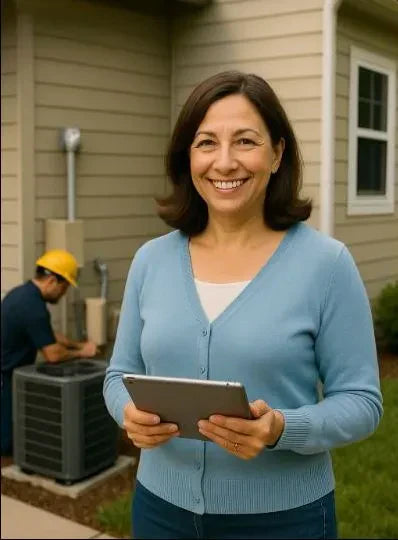Cost Breakdown: Buying vs Operating an R-32 AC System
Beyond the Price Tag
When shopping for a new AC system, most homeowners focus on the sticker price. However, the true cost of ownership extends far beyond the upfront payment. Installation quality, energy efficiency, maintenance, and long-term operating expenses all add up to the real number that matters.
That’s why it’s essential to consider both sides: buying costs and operating costs. With R-32 refrigerant now becoming the new standard, you’ll want to understand how this technology affects both. Spoiler: it often saves you more in the long run.
And remember—since most homeowners purchase AC + air handler systems together, the real cost picture depends on how well these paired components are sized, installed, and maintained.
Upfront Costs: Buying an R-32 AC System
Equipment Price
R-32 systems are often slightly more expensive than older R-410A models. Why? They’re newer, designed for higher efficiency, and use a next-generation refrigerant.
-
Entry-level systems: $5,000–$7,000 (installed)
-
Mid-range systems: $7,500–$9,500
-
Premium variable-speed systems: $10,000–$14,000
The National Renewable Energy Laboratory (NREL) notes that efficiency-driven systems like R-32 ACs typically carry a 5–15% higher initial price compared to legacy models (NREL – HVAC Efficiency Report).
Installation Costs
Labor and materials vary by home size and ductwork condition. A study in the Journal of Construction Engineering and Management found that installation quality directly affects both cost and long-term performance (ASCE – Construction Engineering).
-
Duct upgrades or sealing add $1,000–$3,000.
-
Electrical upgrades can add another $500–$1,500.
Operating Costs: Where the Real Savings Happen
Energy Bills
R-32 systems are designed for high SEER2 efficiency. That means less electricity for the same cooling output.
The U.S. Energy Information Administration (EIA) reports that air conditioning accounts for about 12% of annual home electricity use in the U.S. (EIA – Residential Energy Consumption).
Switching to a higher-SEER2 R-32 system can lower bills by 20–30%. Example:
-
Old 10 SEER system = $1,200/year
-
New 18 SEER2 R-32 system = ~$850/year
Maintenance Costs
Routine upkeep—filters, coil cleaning, annual inspections—averages $150–$300/year. Well-maintained R-32 systems typically last 12–15 years.
A Building Services Engineering Research & Technology study found that preventive maintenance reduces lifetime HVAC costs by up to 40% (SAGE Journals – BSER&T).
Repairs and Longevity
Older refrigerants like R-410A are being phased out. That means future repairs (like refrigerant recharges) will cost more. With R-32, you’re buying into the standard of the future—ensuring parts and service stay widely available.
Environmental Costs: The Hidden Factor
While homeowners often focus on dollars, refrigerants carry environmental “costs” too.
-
R-410A GWP: ~2088
-
R-32 GWP: ~675 (about 70% lower)
The Intergovernmental Panel on Climate Change (IPCC) emphasizes that transitioning to lower-GWP refrigerants like R-32 is critical to meeting climate goals (IPCC AR6 – Climate Change Report).
Translation: choosing R-32 helps reduce your household’s carbon footprint.
Incentives and Rebates
Government and utility programs often provide rebates for high-efficiency systems. Many require a certain SEER2 threshold.
The U.S. Department of Energy lists rebate opportunities through the Database of State Incentives for Renewables & Efficiency (DSIRE) (DOE – DSIRE).
These programs can shave $500–$2,000 off your upfront costs.
Total Cost of Ownership: An Example
Let’s compare a 3-ton R-32 system with a similar older R-410A system.
| Cost Category | R-410A System | R-32 System |
|---|---|---|
| Purchase + Install | $7,500 | $8,500 |
| Annual Energy Bills | $1,200 | $850 |
| Maintenance (15 yrs) | $4,500 | $4,500 |
| Lifetime Repairs | $3,000 | $2,000 |
| 15-Year Total | $32,500 | $28,250 |
Even with a higher upfront cost, the R-32 system saves $4,250 over 15 years.
Common Myths About R-32 Costs
-
“It’s too new—repairs will be more expensive.” False: R-32 is already mainstream globally. Parts and service are readily available.
-
“I should stick with cheaper R-410A.” Short-term savings mean higher bills and repair costs later.
-
“Maintenance is optional.” Skipping it guarantees higher costs down the road.
Conclusion: The Smarter Investment
When you look beyond the sticker price, an R-32 AC system proves to be the smarter financial and environmental choice.
-
Slightly higher upfront, but lower bills every month
-
Future-proof refrigerant that won’t drive up repair costs
-
Rebates and incentives to sweeten the deal
-
Long-term comfort and peace of mind
In short: with R-32, you’re not just buying cooling—you’re buying smarter, cleaner, and more cost-effective comfort.







